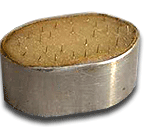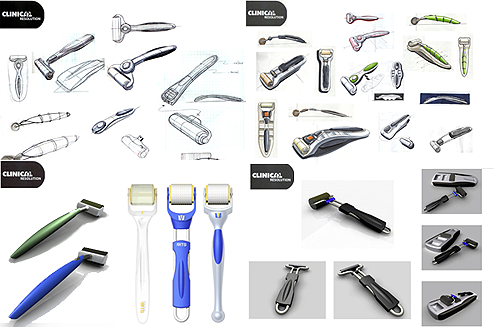|
BACKGROUND OF PERCUTANEOUS COLLAGEN INDUCTION THERAPY
Facial skin resurfacing can be traced to ancient Egyptian times and the application of abrasive masks of alabaster particles. For millennia, various substances have been used to peel, exfoliate, and rejuvenate the skin. These substances include acids, poultices of minerals and plants, and direct irritants such as fire and sandpaperlike materials.
The Early Stage
The evolution of chemical peeling and skin abrasion into the procedures in common use today began in the early 20th century. In 1905, a German dermatologist Kromayer first reported controlled resurfacing abrasion of the skin. His technique involved the use of rotating wheels and rasps and, except for technical improvements of the equipment, differed very little from present-day skin abrasion. He treated acne scars, keratoses, and areas of hyperpigmentation.
 Despite this early report of the use of surgical planing, skin abrasion did not gain widespread popularity until the early 1950s, when Kurtin, McEvitt, and others published numerous articles on skin abrasion, leading to a rediscovery of the technique. Kurtin presented the first series of patients who underwent skin abrasion to Mount Sinai Hospital in 1953. Kurtin described the use of high-speed rotary abraders, intraoperative freezing, and a variety of abrasive end pieces. Moderate skin abrasion technique was developed in Italy in early 1980's by Swissfrench dermatologist, Dr. Philippe Simonin utilizing electroridopuncture technique with microcurrent and acupuncture needling; its use was widespread in European countries prior to its introduction and popularity in the United States. Despite this early report of the use of surgical planing, skin abrasion did not gain widespread popularity until the early 1950s, when Kurtin, McEvitt, and others published numerous articles on skin abrasion, leading to a rediscovery of the technique. Kurtin presented the first series of patients who underwent skin abrasion to Mount Sinai Hospital in 1953. Kurtin described the use of high-speed rotary abraders, intraoperative freezing, and a variety of abrasive end pieces. Moderate skin abrasion technique was developed in Italy in early 1980's by Swissfrench dermatologist, Dr. Philippe Simonin utilizing electroridopuncture technique with microcurrent and acupuncture needling; its use was widespread in European countries prior to its introduction and popularity in the United States.
Subcision
The first to notice the major advantages of skin needling were Orentreich et al in 1995. They were the first to introduce the term Subcision® from the contraction of the term ‘‘Subcutaneous Incinsionless’’ surgery. It is a method of cutting under a depressed scar, wrinkle or contour using a tri-beveled hypodermic needle inserted under the skin through a needle puncture, adjacent to the scar. The procedure attempts to raise the base of the defect to the level of the surrounding skin surface by 2 distinct mechanisms:
The act of surgically releasing the skin from its attachment to deeper tissues results in skin elevation.
The introduction of a controlled trauma initiates wound healing with consequent formation of connective tissue that augments the depressed scar.
The technique involves 3 different approaches:
- simple linear inserting-withdrawing movement of the needle under the scar.
- fanning horizontal movement of the needle under the scar.
- vertical movement of the needle under the scar.
Advanced Needle Abrasion
The next important publication concerning skin needling was reported by Dr. Andre Camirand et al. who in his article in 1997 described his experience with this method. On a number of his patients with facial hypochromic scars, he tattooed the scars with a skin-color pigment. After 1-2 years, they noticed that even though the pigment was long gone, it was replaced by actual melanin, while the scars were immensely improved in texture, appearance and color. This gave the idea that trepenation (coming from the Greek word –Trepanon: to bore) of scars with the tattoo gun was responsible for the improvement and the repigmentation of the scar. They came up with the idea that puncturing of the scar with a tattoo gun alone, without pigment, would in a way break down the scar collagen, cause realignment and stimulate melanogenesis. The results of repetitive sessions on scars were reported by Camirand et al. to be more than good and typically consistent, since all of his patients profited aesthetically from this type of treatment.
 Following to Dr Camirand's development, Dr. Des Fernandes introduced needling device, a small needle stamp, to induce collagen and used as a regular treatment in his surgical practice. He delivered his first paper on skin needling of the upper lips to the ISAPS congress in Taipei 1996. Following to Dr Camirand's development, Dr. Des Fernandes introduced needling device, a small needle stamp, to induce collagen and used as a regular treatment in his surgical practice. He delivered his first paper on skin needling of the upper lips to the ISAPS congress in Taipei 1996.
 Needle Stamp designed by Dr. Des Fernandes Needle Stamp designed by Dr. Des Fernandes
Development of Advanced Needle Device
After extensive research and further development of the skin needle abrasion technology, Clinical Resolution Laboratory, a California Company in U.S.A., re-invented new pattern of the device, called MTS Roller, and released the instrument to the public in 2004.

The First generation of MTS Roller by Clinical Resolution Laboratory. 
Comparing the all abovementioned techniques with the MTS Roller, it is evident that the MTS Roller combines the best features of both techniques and at the same time offers additional advantages. Rolling of the MTS Roller over the skin will cause hundreds of miniscule wounds on the dermis, while creating tiny holes on the epidermis, which will close in hours. This will start up an aseptic inflammation process, which will result in collagen production. The number of punctures caused by the MTS Roller‚ is dozens of times more than the number of punctures created by a tattoo gun or any other methodes developed prior.
The Birth of Microneedle Therapy System
After the great invention of MTS Roller, there was still a missing link between MTS Rollers and its application & use to benefit people in an easy, convenient manner. In the endless efforts to apply the concept of the dermaroller in our daily life against their aging process and to make a difference in our lives, Clinical Resolution Lab (CRL) has completed a missing link with its clinically proven peptide based products in the below treatment areas. In 2004, CRL launched “Mirconeedle Therapy System Association” to further develop the extended needs and undiscovered application of the MTS Rollers, which will function as a centralized MTS education center as well as systematically well-organized worldwide MTS forum. We have defined the entire cosmeceutical treatments using MTS Rollers as Microneedle Therapy System (MTS) in the world. The core MTS treatments include;
- Natural Collagen Inducing Therapy against acute and/or chronic aging.
- Enhanced Wound Healing Solution via Transdermal Drug Delivery System
- Obesity (Fatty Cell)
- Stretch Mark
- Acne Scar Removal
- Psoriasis, Itchiness & Atopy
- Nucleic Acids (DNA/RNA & their protein synthesis Solution)
- Alopecia – Hair Restoration
- Pigment Stabilization
- Growth Hormone Stimulating Peptides/Amino Acids
- Anesthetic Crème

Next: Technology - 
|



